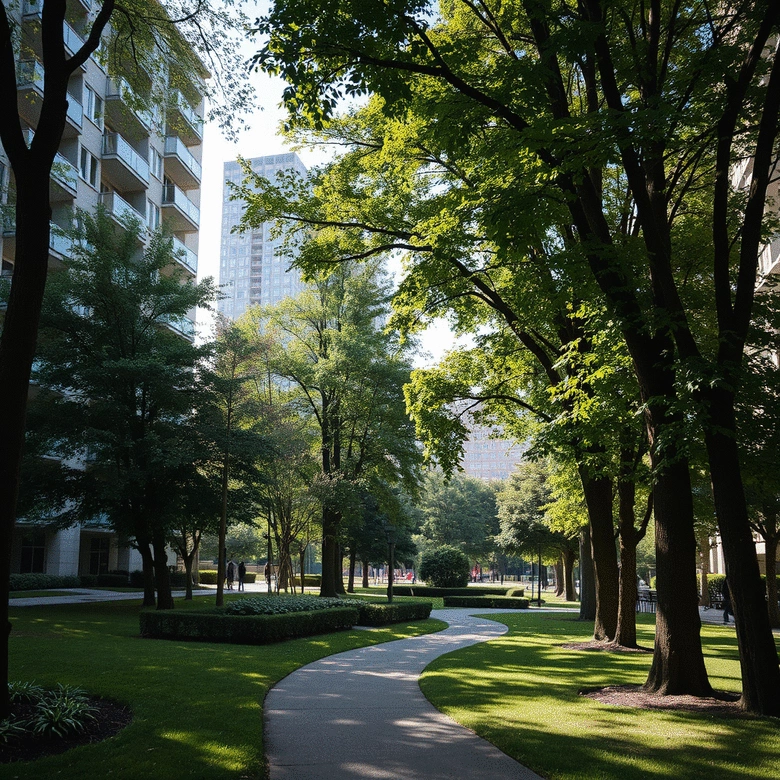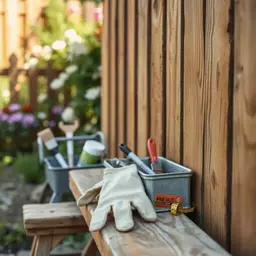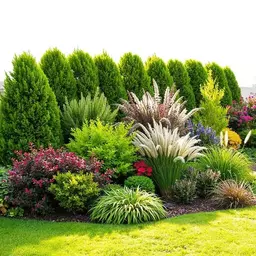Trees for Urban Privacy Benefits
With urbanization on the rise, the need for privacy in our homes has never been more critical. Trees play a vital role in enhancing urban privacy while also adding beauty and sustainability to our landscapes. Discover how integrating trees into your outdoor spaces can transform your environment and elevate your quality of life.
What You Will Learn
- Urban privacy is essential for well-being and creates a comfortable outdoor atmosphere.
- Trees serve as natural privacy barriers, providing both visual and acoustic seclusion.
- Strategically layering trees and shrubs can enhance privacy and aesthetic appeal in urban designs.
- Understanding local regulations is crucial for successful tree planting and maintaining privacy.
- Trees significantly enhance property values and curb appeal in urban areas.
- Integrating trees aids in stormwater management, contributing to a healthier urban ecosystem.
- Engaging in community tree planting initiatives fosters a sense of pride and improves neighborhoods.
- Promoting sustainable practices, such as native species selection, is key to effective urban forestry.
Benefits of Trees for Urban Privacy and Property Value
Explore the various ways trees enhance urban living, focusing on privacy, property values, and environmental impact. For more ideas on how to create secluded spaces, check out these landscaping ideas for privacy screens.
Mental Well-Being
Enhances mental well-being by creating secluded spaces.
Promotes relaxation and comfort.
Increased Property Values
Mature trees enhance curb appeal.
Properties with trees attract more buyers.
Natural Privacy Barriers
Trees serve as living screens, improving privacy.
Strategic placement can maximize coverage.
Stormwater Management
Trees absorb rainfall and reduce runoff.
Promote healthier urban ecosystems.
Understanding the Role of Trees in Urban Privacy Solutions
In today’s bustling urban environments, the need for privacy has never been more pressing. As our cities expand and homes are built closer together, residents often find themselves yearning for a sense of seclusion in their outdoor spaces. That’s where trees come into play. At Branch & Border, we believe that trees are not just beautiful additions to your landscape; they serve as essential components in enhancing urban privacy solutions!
Defining Urban Privacy: Why It Matters
Urban privacy is about creating a sense of separation between spaces, helping residents feel comfortable and secure in their homes. It’s essential for fostering a peaceful atmosphere, especially in densely populated areas. When we think about privacy, it’s more than just what we can see; it’s about how we feel in our own outdoor spaces.
Privacy contributes to our overall well-being. It allows us to enjoy our backyards, gardens, and balconies without the constant worry of being watched. By incorporating nature into our designs, we can create environments that provide comfort, relaxation, and a touch of tranquility amidst the urban bustle.
- Enhances mental well-being
- Encourages outdoor activities
- Offers a peaceful retreat
How Trees Serve as a Natural Privacy Barrier
Trees can effectively act as natural privacy barriers, and their benefits extend beyond aesthetics. They create a living screen that not only obscures views but also adds beauty to our surroundings. Various tree species can be strategically placed to achieve maximum coverage, providing both visual and acoustic privacy. For year-round visual barriers, consider exploring evergreens for all-season privacy fencing.
Different types of trees serve unique purposes. For instance, tall evergreens like spruces or pines can create a dense wall of greenery year-round, while flowering deciduous trees can offer seasonal beauty while still maintaining a level of privacy. By selecting the right types, we can ensure that you enjoy both protection and appeal.
- Evergreens for year-round coverage
- Deciduous trees for seasonal beauty
- Mixed plantings for diverse aesthetics
Privacy Screening: Integrating Trees into Urban Design
Integrating trees into urban design requires thoughtful planning and execution. When designing for privacy, it’s vital to consider the layout of your space. Think about how trees can be used to block sightlines from neighboring properties while enhancing the overall landscape.
In my experience with Branch & Border, successful privacy screening often involves layering plants. Taller trees can be placed at the back, with mid-sized shrubs in front, followed by low-growing plants. This not only creates depth but also ensures that your privacy screen flourishes and thrives!
- Layering trees and shrubs for effective coverage
- Positioning plants for optimal sunlight and growth
- Incorporating seasonal changes for visual interest
Pro Tip
When planning to plant trees for privacy, consider the growth patterns and root structures of different species. Some trees can become invasive or disrupt nearby structures. Selecting native species not only supports local wildlife but also minimizes maintenance and ensures your privacy screen thrives effectively.
Addressing Common Questions About Trees for Urban Privacy
What are the Legal Considerations for Planting Trees for Privacy?
When considering planting trees for privacy, it's essential to be aware of local regulations. Many urban areas have specific guidelines regarding tree height, species selection, and placement relative to property lines. Understanding these regulations can save you from potential disputes with neighbors or local authorities!
Here are some common legal considerations to keep in mind:
- Setback Requirements: Ensure trees are planted at a safe distance from property boundaries.
- Height Restrictions: Check local laws for limitations on how tall your trees can grow.
- Permits: Some municipalities require permits for planting certain species or for large-scale planting projects.
At Branch & Border, we always encourage clients to research these aspects to ensure their tree selections align with local laws while maximizing privacy benefits. For instance, similar considerations apply when designing shrub living fences.
How Do Trees Impact Property Values in Urban Areas?
Research shows that trees can significantly enhance property values in urban settings! A well-placed tree not only adds beauty but also creates a sense of community and charm that buyers appreciate. Homeowners should consider how strategic planting can increase their property appeal.
Some key points about trees and property values include:
- Increased Curb Appeal: Mature trees create an inviting atmosphere.
- Market Demand: Properties with trees often attract more buyers.
- Energy Savings: Trees can lower cooling costs in the summer, making homes more appealing.
As a landscape designer, I’ve seen firsthand how the right trees can transform a property, making it more desirable while also enhancing privacy and sustainability.
How Can Trees Contribute to Stormwater Management?
Trees play a vital role in urban stormwater management by absorbing rainfall and reducing runoff. This is especially important in areas prone to flooding or where the urban heat island effect is prominent. By integrating trees into your landscape design, you’re contributing to a healthier urban ecosystem!
Here are several ways trees help manage stormwater:
- Rainwater Absorption: Tree roots absorb significant amounts of rainfall, reducing surface runoff.
- Soil Permeability: Healthy soil around trees allows water to seep in, replenishing groundwater supplies.
- Canopy Coverage: Tree canopies slow down rainfall, decreasing the speed and volume of water reaching the ground.
At Branch & Border, we prioritize planting techniques that maximize these benefits, ensuring our designs not only boost privacy but also support sustainable urban living.
FAQs About Trees for Urban Privacy
Here are some frequently asked questions about using trees for urban privacy:
- Q: What types of trees are best for year-round privacy?
A: Evergreens like spruces, pines, and arborvitae are excellent choices for year-round privacy due to their dense foliage. - Q: How far should trees be planted from property lines for privacy?
A: It depends on local regulations and the mature size of the tree. Always check local setback requirements to avoid disputes. - Q: Can trees really reduce noise from urban areas?
A: Yes, dense tree plantings can significantly help in absorbing and deflecting urban noise, contributing to acoustic privacy. - Q: Do privacy trees require a lot of maintenance?
A: Maintenance varies by species. Some, like fast-growing evergreens, may require regular pruning to maintain shape and density, while native species often require less. - Q: How long does it take for trees to provide effective privacy?
A: The time frame depends on the tree species and its growth rate. Fast-growing trees can offer substantial privacy within a few years, while slower-growing species may take longer.
Summarizing the Benefits of Trees for Privacy in Urban Settings
Recap of Key Benefits and Practical Steps Forward
As we’ve explored, trees offer a myriad of benefits for urban privacy, including enhanced beauty, improved air quality, and privacy screening. They serve as natural barriers while contributing to a more sustainable environment. So, what’s your next step in this green journey?
Consider these practical actions:
- Assess Your Space: Determine which areas could benefit most from tree planting.
- Research Suitable Species: Choose trees that thrive in your environment and meet your privacy needs.
- Plan for Maintenance: Keep in mind the long-term care required for your chosen trees.
With a thoughtful approach, you'll be well on your way to enjoying the numerous advantages that trees can bring to your urban landscape!
Encouraging Community Engagement and Advocacy for Urban Tree Planting
Tree planting is more than just a personal project; it’s a community effort! By advocating for urban trees, you’re not only enhancing your own property but also contributing to the shared well-being of your neighborhood. Engaging with local tree planting initiatives can foster a sense of community pride and connection.
Here are some ways to get involved:
- Join Local Organizations: Participate in tree planting events or community forestry programs.
- Educate Others: Share the benefits of trees with neighbors and friends.
- Collaborate with Local Government: Support policies that promote urban forestry and tree planting.
At Branch & Border, we believe that every tree planted contributes to a greener, healthier future for everyone!
Promoting Sustainable Development Through Urban Tree Initiatives
As urban areas continue to grow, promoting sustainable tree initiatives becomes crucial. Trees are not just a luxury; they are essential components of healthy urban ecosystems. By prioritizing tree planting, we can ensure that cities remain livable and vibrant for generations to come.
Consider these sustainable practices in your urban tree initiatives:
- Native Species Selection: Choose trees that are native to your area for better adaptability and lower maintenance.
- Community Involvement: Engage local residents in tree planting efforts to foster stewardship.
- Educational Workshops: Host events to teach the community about the ecological benefits of trees.
Let’s work together to create urban environments that thrive through nature! With my experience and passion at Branch & Border, I'm here to guide you on this journey of transformation. Learn more about selecting the best plants for living fences to enhance your urban green spaces.
Recap of Key Points
Here is a quick recap of the important points discussed in the article:
- Understanding Urban Privacy: Trees enhance mental well-being, encourage outdoor activities, and create peaceful retreats in urban settings.
- Natural Privacy Barriers: Select tree species strategically, such as evergreens for year-round coverage and deciduous trees for seasonal beauty.
- Effective Planting Strategies: Layering trees and shrubs optimizes privacy and creates depth in landscape design.
- Legal Considerations: Be aware of local regulations regarding tree height, species, and planting permits to avoid disputes.
- Impact on Property Values: Mature trees enhance curb appeal and attract more buyers, contributing to higher property values.
- Stormwater Management: Trees absorb rainfall, reduce runoff, and support a healthier urban ecosystem.
- Community Engagement: Advocate for urban tree initiatives and participate in local programs to enhance neighborhood well-being.
- Sustainable Practices: Choose native species and involve the community in tree planting to promote sustainable urban environments.






